|
FAQs about Sea Fan Identification
1
Related Articles: Sea
Fans,
Related FAQs: Sea Fan
ID 2, Sea Fan ID 3, Sea Fan ID 4, & Sea
Fans 1, Sea Fans 2,
Sea Fan Behavior, Sea Fan Selection, Sea Fan Compatibility, Sea Fan Systems, Sea Fan Feeding, Sea Fan Disease, Sea Fan Reproduction,
|
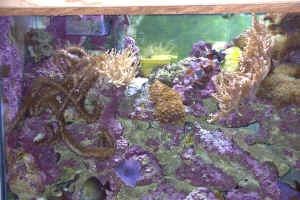
|
| Gorgonian ID and care 12/22/05 I recently purchased a
similar gorgonian. I cant seem to find any info on it. <It is
always better to research an animals needs before
purchase! It is impossible to ID the gorgonian in the
picture you sent, and even more impossible to know if yours is the
same. Gorgonian care is highly variable, except that
almost all require strong current. Brightly colored
specimens are generally non-photosynthetic and require large
amounts of often highly specialized food. Most of these
are doomed to waste away and die. Generally gray and
brown specimens (and some purple ones) are photosynthetic and so
require bright light. These specimens still appreciate
food, but are less dependent on it. If you are confident
that your specimen is NOT photosynthetic, I would try to return it
to the dealer. If they will not accept it back, you can
attempt to provide it with adequate food (baby brine shrimp,
Cyclops-eeze, oyster eggs are all reasonable to try). If
you think it is photosynthetic, then bright light and strong
current should do the trick. All gorgonians will also
benefit from the presence of plankton generating
refugia. Best Regards. AdamC.> |
|
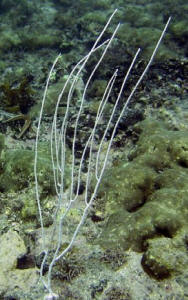
|
| Identification gorgonian
1/10/04 Hello to you WWM Crew :) At first I want to say sorry
for my English; it's not my native language :). <Hello
Petra! No apologies necessary, your English is
outstanding!> Pease can you help me to identify my gorgonian?
I've looked all around the internet but I can't seem to
find what species it is. It has a bumpy white base, grows
treelike and has small light orange polyps which come out at night.
<Hmm... Looks like Swiftia sp., but Swiftia is
generally all bright red/orange. Perhaps this is an odd
morph or bleached.> (I hope they will come out in the light at
sometime :)) <They may. "teasing" it with
food additions during the day may help in this regard.> I am
feeding it with phytoplankton 3 times a week. At some of the tips
the black skeleton is visible :(. Should I remove these parts or
will the living tissue come back? <Since you are feeding
phytoplankton, I guess you know that this gorgonian is not
photosynthetic. The problem is, phytoplankton may be an
appropriate food, but it may not be. These animals are
very specific in the size and type of prey they will accept, and
meeting those requirements is very hard to do. You may
want to try some other food sources (rotifers, baby brine shrimp,
etc.), but unfortunately I suspect that it will continue to recede
until it dies. You can remove the exposed skeleton with
a sharp scissors, and it may get re-covered by tissue, but probably
not.> Well I hope I haven't asked to much questions at once,
but your website has been very helpful so far. <Please ask all
the questions you want, that is why we are here! Best
regards! Adam> Hoping to hear from you soon,
greetings, Petra |
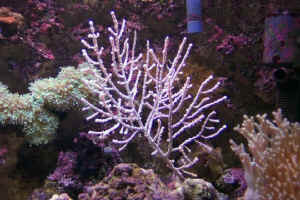 |
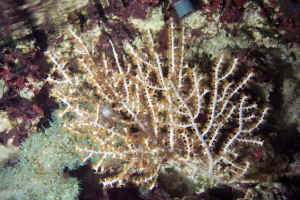 |
Gorgonian ID Key, Stocking Query Dear crew! We are
dealing with the animal husbandry and we've a lot of problems.
Recently we purchased two unidentified gorgon Arians . The first one
forms a bushy red colony with white polyps & thorn-like cups,25 cm
tall. The second one is a tree-like brown colony with blue polyps 15
cm. tall. We assume that they are Muriceopsis flavida & Eunicea
succinea, but we are far from to be sure. Could you send an
identification key? <Mmm, no. Don't have. There are some
in-print reference works (e.g. Alderslade et al.), but no such on-line
source as far as I'm aware> Both they were in the quarantine
about 2 month. Now they are melting, Their polyps are closed, & in
the second species the tips of branches are shrinking. May this be a
melting consequence? <Yes... I proscribe the keeping of just a few
species for the trade, for sale... these are described, listed on
WetWebMedia.com> Could you also inform us about the hydrochemistry,
in particular, Ca, Sr, Mg and the with the other Cnidaria. <Posted
on WWM> P. s. What do your think about the following livestock: 1
Euphyllia glabrescens (diameter (d)=10 cm), 1 Sinularia sp. (25 cm
tall), 3 specimens of Alcyonium sp.(50 cm tall), 1 Galaxea sp. (d=5
cm.), 1 sphaeric colony of Goniopora (d=15 cm), <Am not a fan of the
aquarium use of this genus> 1 colony of Cladiella sp. (25 cm. tall),
4 specimens of Sarcophyton sp.(2x20, 15 & 10 cm), 2 specimens of
Lobophyton sp. (25 & 20 cm tall)& 2 colonies of the gorgon
Arians mentioned in 250 gal aquarium (assuming that all the other
factors are normal one)? <Could, can be done, given space between
all. Bob Fenner> Best Interzoo.
| Coral ID. Hi all, just have a quick ID
question. The LFS sold this rock to me as "live rock"
(sorry about the picture quality). <Not too bad, good
enough.> I know it's not that, but I'm having a hard
time pinning it down. It has pink, leathery skin and tan polyps
that are about 3/8 inch high with 8 "fingers". The polyps
retract at night and the skin becomes shiny. It is spreading to the
other rock that it comes into contact with. <Yes, very
prolific.> It's probably common but I haven't had any
luck on the ID. Thanks for any help you can provide. ~Danny B. in
Blanco, Texas <Well Danny, what you have there is likely
Erythropodium, possibly Briareum, but my bet is on the former. It
is a very fast spreader and rather noxious. -Steven Pro> |
|
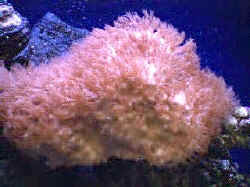
|
| Help with coral
ID Hola Robert :) <Hola, Edgar... Anthony Calfo in your
service.. a fellow reefer, and reef author> Edgar From Mexico
again :) hope the troubles with the page can be solved soon, I was
really scared of thinking the page was gone. Now to business. I
wonder if you could help me to identify a soft coral I have. Is an
octocoral and I think is Clavularia sp, but some of my friends say
might be anthelia or even Xenia (which, if its true, will make me
happy :) ) the polyps are small (1 inch height), the arms
(pinnules? are "branched". its color is light brown. and
they close at night and retract the arms, leaving only a
"bump". I have to pictures which I could send you if you
like. thanks edg <please do send a pic, I suspect that it can be
ID'ed quickly with a reasonably good photo. With kind regards,
Anthony> |
| Re: Help with
coral ID Anthony, Here are two pictures of how much the
polyps have grown in 6 mo. picture 001 the lower mass is the
newest, the piece up (center) is the original. it grows onto the
rear tank glass (picture 002) some where around 10"+ in
diameter. This is where I cut from and glued it onto other rocks.
Can you tell what kind it is? As soon as I get a good tank picture
I'll send it. Anthony, <Absolutely... nice picture too,
thank you. It is Erythropodium...AKA "encrusting
Gorgonian". a hardy and fast growing animal that is similar to
Briareum from the Pacific but is distinguished by its smooth mat of
fused stolons and usual brown/gray color (Briareum stolons are
purple, calyces are raised). A little caution here as Erythropodium
actively seeks some other corals to encrust upon and kill. But
indeed fast growing and fun> <Looking forward to it! Kindly,
Anthony> |
 |
 |
Gorgonian Identification Hi, <Hi
Kevin, MacL here with you today.> You seem to know a lot about
gorgonians, so I was wondering what type this is, it came on a
purple gorgonian that I bought. <Without the polyps being
extended its very hard to tell Kevin. Can you get an additional
picture with them out?> How much do you thing this little frag
would go for? <That's a tough question because price
fluctuates depending on the area.> thank you,
Kevin |
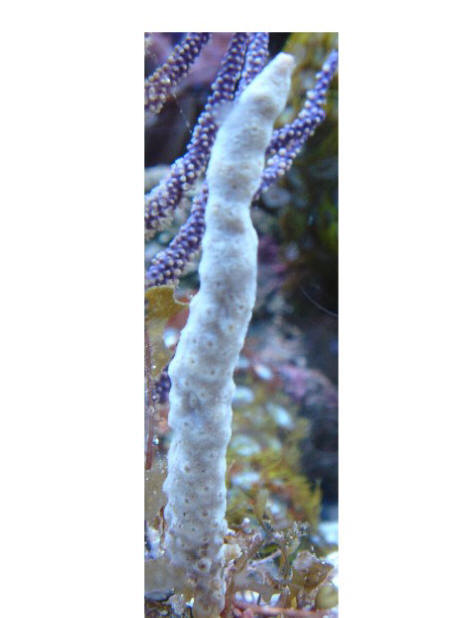 |
Gorgonians me again - just bought a gorgeous blue green
Gorgonian octocorallian from work yesterday, I put it in the direct
path of a powerhead, so it has plenty of circulation and movement, but
there seems to be a lighting dispute - one of my co workers recommended
low light conditions (which I thought to be ridiculous, because I know
they contain Zooxanthellae) but I read your article and I agree with
you. What exactly are their light conditions? thanks Again, Chris
>> Hmmm, really depends on the question of whether the species in
question is photosynthetic or not (yep, some have endosymbiotic algae,
other's don't). I suspect that you have one of the two more
popular Pseudopterygorgia (from the tropical west Atlantic), that
photosynthates... requiring moderate to bright lighting, brisk
circulation... which most all forms/species will tolerate...but do
confirm the species Bob Fenner
Gorgonian Care, 9/19/03 In my local pet store they had what
was labeled as a Gorgonian Ribbon. What is this and what is
the care involved? Caryn <lets see if we can find its genus first...
I wonder/suspect you may be looking at a Pterogorgia species (a sea
whip...sometimes called "ribbons"). Use that genus to do a
search of the web for pictures to see if it looks like a similar
creature. If so, they are fairly hardy if given very strong water
movement and medium to bright light. Fluorescent lamps will be
tolerable if the aquarium is shallow (24" or less) with the
gorgonian in the top half of the tank. Best regards, Anthony>
| Coral ID and mature reef display...Kudos!
Greetings! Could you tell me what the large coral on the
left of this picture is? <it is an Atlantic
Gorgonian Octocoral.. perhaps Muricea or Eunicea. One of the
hardiest species. A delight to see> This is my 10-year old 45
gal tank. The Scopas tang at the bottom will be 11 next
month (that's how long I've had him, anyway.)
<outstanding my friend! Kudos to you. Very inspiring for the
rest of us> Thanks, <best regards, Anthony> |
|

|
|
|

